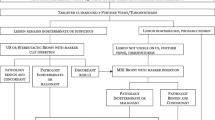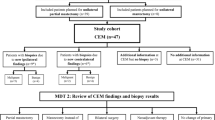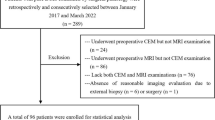Abstract
Purpose
To compare the diagnostic performance (detection, assessment of correct disease extent and multifocality/centricity) of Contrast-Enhanced Mammography (CEM) Versus Breast Magnetic Resonance (MRI) in the study of lobular neoplasms.
Methods
We retrospectively selected all the patients who underwent surgery for a lobular breast neoplasm, either an in situ or an invasive tumor, and had undergone both breast CEM and MRI examinations during the pre-surgical planning. Wilcoxon Signed Rank test was performed to assess the differences between size measurements using the different methods and the post-surgical pathological measurements, considered the gold standard. The agreement in identifying multifocality/multicentricity among the different methods and the pathology was assessed using the Kappa statistics.
Results
We selected 19 patients, of which one presented a bilateral neoplasm. Then, the images of these 19 patients were analyzed, for a total of 52 malignant breast lesions. We found no significant differences between the post-surgical pathological size of the lesions and the calculated size with CEM and MRI (p-value of the difference respectively 0.71 and 0.47). In all 20 cases, neoplasm detection was possible both with CEM and MRI. CEM and MRI showed an excellent ability to identify multifocal and multicentric cases (K statistic equal to 0.93 for both the procedures), while K statistic was 0.11 and 0.59 for FFDM and US, respectively.
Conclusion
The findings of this study suggest that CEM is a reliable imaging technique in the preoperative setting of patients with lobular neoplasm, with comparable results to breast MRI.



Similar content being viewed by others
Data availability
The datasets used and/or analyzed during the current study are available from the corresponding author on reasonable request.
References
Łukasiewicz S, Czeczelewski M, Forma A, Baj J, Sitarz R, Stanisławek A (2021) Breast cancer-epidemiology, risk factors, classification, prognostic markers, and current treatment strategies-an updated review. Cancers (Basel) 13(17):4287. https://doi.org/10.3390/cancers13174287
Oliveira TM, Elias J Jr, Melo AF, Teixeira SR, Filho SC, Gonçalves LM, Faria FM, Tiezzi DG, Andrade JM, Muglia V (2014) Evolving concepts in breast lobular neoplasia and invasive lobular carcinoma, and their impact on imaging methods. Insights Imaging 5(2):183–194. https://doi.org/10.1007/s13244-014-0324-6
Li CI, Anderson BO, Daling JR, Moe RE (2003) Trends in incidence rates of invasive lobular and ductal breast carcinoma. JAMA 289:1421–1424
Van Baelen K, Geukens T, Maetens M, Tjan-Heijnen V, Lord CJ, Linn S, Bidard FC, Richard F, Yang WW, Steele RE, Pettitt SJ, Van Ongeval C, De Schepper M, Isnaldi E, Nevelsteen I, Smeets A, Punie K, Voorwerk L, Wildiers H, Floris G, Vincent Salomon A, Derksen PWB, Neven P, Senkus E, Sawyer E, Kok M, Desmedt C (2022) Current and future diagnostic and treatment strategies for patients with invasive lobular breast cancer. Ann Oncol 33(8):769–785. https://doi.org/10.1016/j.annonc.2022.11.010
Li CI, Malone KE, Daling JR (2002) Differences in breast cancer hormone receptor status and histology by race and ethnicity among women 50 years of age and older. Cancer Epidemiol Biomarkers Prev 11(7):601–607
Girardi A, Magnoni F, Vicini E, Kouloura A, La Vecchia C, Veronesi P, Corso G (2022) CDH1 germline mutations in families with hereditary lobular breast cancer. Eur J Cancer Prev 31(3):274–278. https://doi.org/10.1097/CEJ.0000000000000688
Magnoni F, Corso G (2022) Progress in breast cancer surgical management. Eur J Cancer Prev 31(6):551–553. https://doi.org/10.1097/CEJ.0000000000000741
Yeatman TJ, Cantor AB, Smith TJ et al (1995) Tumor biology of infiltrating lobular carcinoma. Implications for management. Ann Surg 222(4):549–559
Waljee JF, Hu ES, Newman LA, Alderman AK (2008) Predictors of re-excision among women undergoing breast-conserving surgery for cancer. Ann Surg Oncol 15(5):1297–1303
Thomas M, Kelly ED, Abraham J, Kruse M (2019) Invasive lobular breast cancer: a review of pathogenesis, diagnosis, management, and future directions of early-stage disease. Semin Oncol 46:121–132
Mann RM, Loo CE, Wobbes T et al (2010) The impact of preoperative breast MRI on the re-excision rate in invasive lobular carcinoma of the breast. Breast Cancer Res Treat 119(2):415–422
Heil J, Buehler A, Golatta M et al (2012) Do patients with invasive lobular breast cancer benefit in terms of adequate change in surgical therapy from a supplementary preoperative breast MRI? Ann Oncol 23(1):98–104
Ha SM, Chae EY, Cha JH, Kim HH, Shin HJ, Choi WJ (2018) Breast MR imaging before surgery: outcomes in patients with invasive lobular carcinoma by using propensity score matching. Radiology 287(3):771–777. https://doi.org/10.1148/radiol.2018171472
Costantini M, Montella RA, Fadda MP, Tondolo V, Franceschini G, Bove S, Garganese G, Rinaldi PM (2022) Diagnostic challenge of invasive lobular carcinoma of the breast: what is the news? Breast Magnetic Resonance Imaging and emerging role of contrast-enhanced spectral mammography. J Pers Med 12(6):867. https://doi.org/10.3390/jpm12060867
Lobbes MBI, Neeter LMFH, Raat F, Turk K, Wildberger JE, van Nijnatten TJA, Nelemans PJ (2023) The performance of Contrast-Enhanced Mammography and breast MRI in local preoperative staging of invasive lobular breast cancer. Eur J Radiol 164:110881. https://doi.org/10.1016/j.ejrad.2023.110881
Zamora K, Allen E, Hermecz B (2021) Contrast mammography in clinical practice: current uses and potential diagnostic dilemmas. Clin Imaging 71:126–135
Ferranti FR, Vasselli F, Barba M, Sperati F, Terrenato I, Graziano F, Vici P, Botti C, Vidiri A (2022) Diagnostic accuracy of contrast-enhanced, spectral mammography (CESM) and 3T magnetic resonance compared to full-field digital mammography plus ultrasound in breast lesions: results of a (Pilot) open-label, single-centre prospective study. Cancers (Basel) 14(5):1351. https://doi.org/10.3390/cancers14051351
Neeter LMFH, Robbe MMQ, van Nijnatten TJA, Jochelson MS, Raat HPJ, Wildberger JE, Smidt ML, Nelemans PJ, Lobbes MBI (2023) Comparing the diagnostic performance of Contrast-Enhanced Mammography and breast MRI: a systematic review and meta-analysis. J Cancer 14(1):174–182. https://doi.org/10.7150/jca.79747
Lee CH, Phillips J, Sung JS, Lewin JM, Newell MS (2022) Contrast enhanced mammography (CEM) (a supplement to ACR BI-RADS® mammography 2013) atlas, breast imaging reporting and data system. American College of Radiology, Reston
Nicosia L, Bozzini AC, Palma S, Pesapane F, Meneghetti L, Pizzamiglio M, Abbate F, Latronico A, Bagnardi V, Frassoni S, Sangalli C, Cassano E (2023) Breast imaging reporting and data system and contrast enhancement mammography: lesion conspicuity likelihood of malignancy and relationship with breast tumor receptor status. Acad Radiol. https://doi.org/10.1016/j.acra.2023.02.008
Morris EA, Comstock CE, Lee CH, et al. (2013) ACR BI-RADS® Magnetic Resonance Imaging. In: ACR BI-RADS® Atlas, Breast Imaging Reporting and Data System. American College of Radiology, Reston
McCart Reed AE, Kutasovic JR, Lakhani SR, Simpson PT (2015) Invasive lobular carcinoma of the breast: morphology, biomarkers and ‘omics. Breast Cancer Res 17(1):12. https://doi.org/10.1186/s13058-015-0519-x
Porter AJ, Evans EB, Foxcroft LM, Simpson PT, Lakhani SR (2014) Mammographic and ultrasound features of invasive lobular carcinoma of the breast. J Med Imaging Radiat Oncol 58(1):1–10. https://doi.org/10.1111/1754-9485.12080
Selinko VL, Middleton LP, Dempsey PJ (2004) Role of sonography in diagnosing and staging invasive lobular carcinoma. J Clin Ultrasound 32(7):323–332. https://doi.org/10.1002/jcu.20052
Berg WA, Gutierrez L, NessAiver MS, Carter WB, Bhargavan M, Lewis RS, Ioffe OB (2004) Diagnostic accuracy of mammography, clinical examination, US, and MR imaging in preoperative assessment of breast cancer. Radiology 233(3):830–849. https://doi.org/10.1148/radiol.2333031484
Mann RM, Hoogeveen YL, Blickman JG, Boetes C (2008) MRI compared to conventional diagnostic work-up in the detection and evaluation of invasive lobular carcinoma of the breast: a review of existing literature. Breast Cancer Res Treat 107(1):1–14. https://doi.org/10.1007/s10549-007-9528-5
Cocco D, ElSherif A, Wright MD, Dempster MS, Kruse ML, Li H, Valente SA (2021) Invasive lobular breast cancer: data to support surgical decision making. Ann Surg Oncol 28(10):5723–5729. https://doi.org/10.1245/s10434-021-10455-7
Chen Z, Yang J, Li S, Lv M, Shen Y, Wang B, Li P, Yi M, Zhao X, Zhang L et al (2017) Invasive lobular carcinoma of the breast: a special histological type compared with invasive ductal carcinoma. PLoS ONE 12:e0182397
Hogan MP, Amir T, Sevilimedu V, Sung J, Morris EA, Jochelson MS (2021) Contrast-enhanced digital mammography screening for intermediate-risk women with a history of lobular neoplasia. AJR Am J Roentgenol 216(6):1486–1491. https://doi.org/10.2214/AJR.20.23480
Amato F, Bicchierai G, Cirone D, Depretto C, Di Naro F, Vanzi E, Scaperrotta G, Bartolotta TV, Miele V, Nori J (2019) Preoperative loco-regional staging of invasive lobular carcinoma with contrast-enhanced digital mammography (CEDM). Radiol Med 124(12):1229–1237. https://doi.org/10.1007/s11547-019-01116-7
Jochelson MS, Lobbes MBI (2021) Contrast-Enhanced Mammography: state of the art. Radiology 299(1):36–48. https://doi.org/10.1148/radiol.2021201948
Cozzi A, Magni V, Zanardo M, Schiaffino S, Sardanelli F (2022) Contrast-Enhanced Mammography: a systematic review and meta-analysis of diagnostic performance. Radiology 302(3):568–581. https://doi.org/10.1148/radiol.211412
Acknowledgements
This work was partially supported by the Italian Ministry of Health Ricerca Corrente 5x1000 funds.
Funding
This study did not receive funding.
Author information
Authors and Affiliations
Contributions
Conceptualization: LN, OB; AR; methodology: FP and ACB; validation: ACB and GP; resources: NF; EC; writing—original draft preparation: LN and OB; writing—review and editing: all authors. Statystical analysis: SF; VB; data managment: CS; supervision, GC and EC. All authors read and approved the Final manuscript.
Corresponding author
Ethics declarations
Conflict of interest
The authors declare that they have no competing interests.
Ethical approval
The study was conducted according to the guidelines of the Declaration of Helsinki, and approved by the Ethics Committee of the local Institution (European Institute of Oncology, 20141, Milano).
Informed consent
All patients have signed a written informed consent (Protocol number IEO 960).
Additional information
Publisher's Note
Springer Nature remains neutral with regard to jurisdictional claims in published maps and institutional affiliations.
Rights and permissions
Springer Nature or its licensor (e.g. a society or other partner) holds exclusive rights to this article under a publishing agreement with the author(s) or other rightsholder(s); author self-archiving of the accepted manuscript version of this article is solely governed by the terms of such publishing agreement and applicable law.
About this article
Cite this article
Nicosia, L., Rotili, A., Pesapane, F. et al. Contrast-Enhanced Mammography (CEM) compared to Breast Magnetic Resonance (MRI) in the evaluation of breast lobular neoplasia. Breast Cancer Res Treat 203, 135–143 (2024). https://doi.org/10.1007/s10549-023-07096-7
Received:
Accepted:
Published:
Issue Date:
DOI: https://doi.org/10.1007/s10549-023-07096-7




